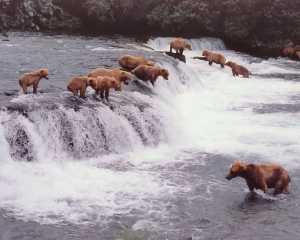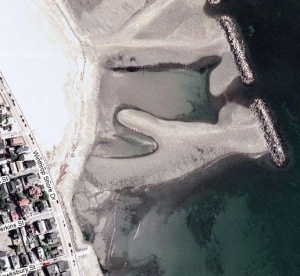Now that striped bass season is upon us, here are a few suggestions for those of you might be saying to yourself, "I have all the gear and the get-up-and-go. But where do I begin? Where do I go?"

Crowd scene. Bears must read newspapers
The easy answer would be to go to where the fish are (or are reported to be). You can often get this information on the Web or in a newspaper or from tackle and bait shops. Lots of places. You can be sure, though, that lots of other fishermen will have access to this same information and by the time you show up it's often a real crowd scene, especially early in the year when everybody is eager to get on the water and tangle with some of these newly-arrived fish.
But suppose you don't enjoy fishing the popular hot spots among crowds of people? Suppose you want to go off on your own and discover your own special place? If you're one of those adventurous anglers, here are a few suggestions (excerpted from my soon to be re-released book, Striper Strategies) that may help you decide...
Find what you like

But no crowds here!
The striped bass fisherman is extremely fortunate in having a wide variety of water in which to pursue his sport. Stripers can be found almost anywhere there's water to hold them. But because there are so many choices, making a choice can be difficult at times, especially for the newcomer to the sport. Massachusetts, for instance, where I live and where I do most of my fishing, is a fairly small state in area but it has over twelve hundred miles of coastline (including coves, estuaries, etc.). Where do you begin? How do you choose? The most important thing to remember is that the choice is yours. Ask yourself first, What kind of fishing do I or would I most enjoy? Is it flats fishing, rock, pier or jetty fishing? Is it along a sandy beach or the shores of an island? Is it river or estuary fishing? Surfy or serene? Deep water or shallow? And so forth.
Once you've made up your mind what kind of fishing experience you'd like to have, it's now just a matter of going out and doing it. Which leads us back to the original question: Where to go to get the kind of fishing experience you'd like to have? If you're unfamiliar with an area—or even if you are familiar with it—I'd suggest picking up a NOAA chart or a copy of the Mariner's Atlas for the area you're fishing and then sitting down and studying it. These charts are some of the most practical guides a striper fisherman can own. In them can be found detailed coastal and estuarine views of almost any given area along the coast, showing flats, sand bars, shoals, rock formations, holes, as well as many other places where stripers are likely to appear as well as depth soundings, which can be a real boon to the wading fisherman or boater planning a trip to a previously unfished area.
Go Low

Look at all the fish-holding structure only visible at low tide: a deep, winding center channel, large rocks, a sunken log, and the bar at center-left.
Whenever you fish a place for the first time, always try to be there at a time when the tide is low. It's only then that you can see the nature of the bottom and any structure that might attract stripers. It's only then, also, that you can see any holes or channels that may cut across a flat, sand bar or estuary and, with the incoming tide, prevent you, if wading, from returning to the safety of the shore. A good time to begin your acquaintance is to show up about two hours before low tide and then to fish this area until about two hours into the rise. This will give the wading fisherman an opportunity to fish safely at a time when the fishing is generally at its best.
Be constantly aware, also, of the total height of the expected high tide as well as the speed with which the tide is coming in (it varies from day to day - depending on the phase of the moon - and from wind to wind). If the tide is normally a ten-foot tide and you're only 5' 7", it's not an especially good idea to be a long way from shore well into the rising tide. Know how long it takes you to return to shore and give yourself plenty of time to return. I've had several close calls over the years and do not recommend them as fun experiences. When I fish a flat I often take a small inflatable raft with me and stake it out in a safe and reachable location so that I can always make it back to shore dry and safe.
Get into the Rhythm

With a complex mix of bars and channels, the currents in this area will vary widely at different stages of the tide.
In addition to visiting a place for the first time at low tide, I'd also strongly recommend to the angler that at some time he spend at least one complete tide cycle in or on a particular piece of water, observing the bottom structure when the tide is low, watching what happens as the tide comes in (and at various stages of the incoming tide), learning what happens when the tide is high and also when it begins to recede, and staying with the tide until it returns to low again. Take note of its rhythms, as well, its repeated actions throughout several tide changes and the ways in which fish behavior is influenced by these changes.
Given roughly similar circumstances (stage of tide, phase of moon, water temperature, wind, time of day, etc.) what will happen one day will often happen the next day at the same time or stage of the tide. Your observations of the changes that occur at each stage of the tide, of the relative increase or decrease of baitfish or striper activity, and many other useful bits of information gleaned along the way will be of tremendous importance to your development and consistent success as an angler, and will be especially useful knowledge to have and remember when you fish this place again. Your increased ability to predict what will happen - where and when - will help you plan your days on the water in the most efficient manner and will greatly increase your chances for consistent success.






